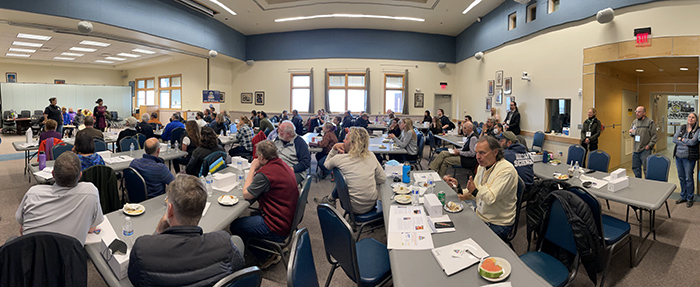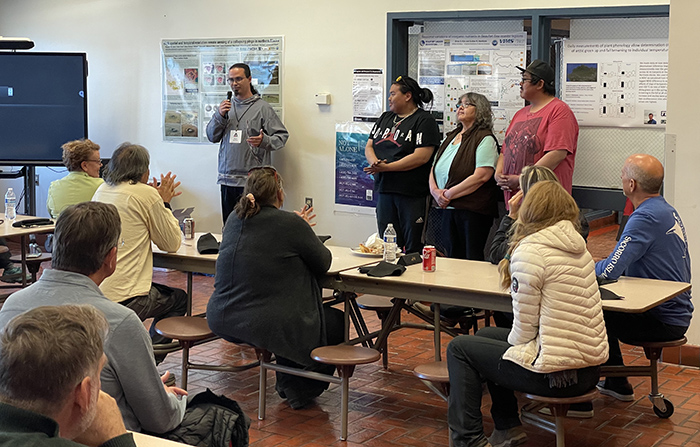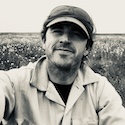By: Benjamin M. Jones, Institute of Northern Engineering, University of Alaska Fairbanks on behalf of the Workshop Organizing and Advisory Committee
This is an unprecedented time to study changes occurring in the Arctic. The impacts of melting sea ice, melting ice sheets, thawing permafrost, ecosystem reorganization, geopolitics, and associated human interactions represent complex issues requiring a reflection on the past, a focus on the current state, and a coordinated and collaborative discussion about priorities for future research and capacity-building investments in Arctic science and engineering. To do this, it is essential to gather researchers, key stakeholders, and community members from numerous generations, disciplines, and cultures to share their observations and insights.
[video: width:700]
In early August 2022, a multidisciplinary, intergenerational, and cross-cultural group of participants converged on Utqiaġvik, Alaska to celebrate the 75th Anniversary of the Naval Arctic Research Laboratory (NARL) and to take part in a National Science Foundation (NSF) funded workshop focused on Enhancing Arctic Science and Engineering (EASE). The foundation of the EASE workshop was grounded in a legacy of promoting sustainable Arctic science in Utqiaġvik, as a model for the circumpolar north, being guided by the important role of the Iñupiat in furthering scientific understanding of climatic and social-ecological change in the rapidly changing Arctic.
The five-day event focused on summarizing science and engineering in Utqiaġvik and the greater North Slope region over the last 75 years, an assessment of the current state of the science and engineering being conducted, and a prospectus on science and engineering in the Arctic over the next 25 years. The workshop included oral and poster presentations and featured keynote speakers that focused on key achievements and past research endeavors to provide the framework for envisioning the trajectory of Arctic science, engineering, and education in the future. Specific themes of the EASE workshop included marine and coastal research, terrestrial and freshwater research, atmospheric research, social science research, co-production of knowledge, convergent research, and education and outreach opportunities.

The gathering included more than 140 participants from academia, federal agencies, nonprofit organizations, industry, community members, and local-to-regional governments and corporations. Participant expertise included natural and social scientists from the range of disciplines reflected in the workshop's themes, as well as engineers, planners, students, and local and Indigenous leaders and knowledge holders. US government representatives came from the National Science Foundation, the National Oceanic and Atmospheric Administration, US Arctic Research Commission, Department of Energy's Arctic Energy Office and Office of Science, Sandia National Laboratories, Pacific Northwest National Laboratory, Lawrence Livermore National Laboratory, US Department of Agriculture, Ted Stevens Center for Arctic Security Studies, and the US Navy. Senator Murkowski and Senator Sullivan's offices each contributed introductory remarks that provided context for the importance of this event in the State of Alaska's history.

The legacy of strong ties between visiting researchers and the Iñupiat community of Utqiaġvik is apparent in the more than 75 years of collaboration and knowledge sharing between scientific approaches and Indigenous Knowledge systems that have shaped the current state of science and knowledge across the Arctic. Scientific research at NARL has historically been an interdependent effort with the Utqiaġvik community, contributing to the local economy, while promoting research and knowledge sharing on topics critical to the stewardship of subsistence resources and community well-being. With the inclusion of tribal, regional, and state planners, including Indigenous leaders and students, the workshop broadened participation from underrepresented groups and diverse institutions in scientific dialogue and knowledge-sharing to build capacity for further contributions to science and engineering.
Today, Utqiaġvik hosts more federally funded Arctic research projects than any other location in the US. The post-workshop reporting activities will provide a roadmap that can be used to guide future research endeavors and investments in Arctic science and engineering that span several disciplines and knowledge frameworks that align with the mission and vision of the NSF Office of Polar Programs, as well as other entities and agencies interested in a rapidly changing Arctic environment. The post-workshop report will help plan for the coordination of future Arctic research efforts and identify logistical and facility needs. The primary focus of the report includes:
- Establishing the current state of knowledge for disciplinary and cross-disciplinary research in the Arctic;
- Identifying current and potential knowledge gaps and research questions that will directly benefit society;
- Incorporating knowledge co-production to foster collaborative, transdisciplinary, and action-oriented research in the Arctic;
- Discussing future research activities, resources, and logistical needs to promote a sustainable, diverse, and inclusive space for Arctic research and co-sharing of Indigenous knowledge to flourish;
- Fostering national and international collaboration that will amplify individual and research program efforts across polar regions, disciplines, and cultures; and
- Continue to develop an inclusive and diverse community that fosters and empowers the next generation of students, early-career researchers, and Indigenous community members that will tackle grand challenges in the future Arctic.
For more information, see the NARL 75th website, which hosts links to the agenda, a list of participants, profiles of the workshop moderators and speakers, presentation materials, zoom recordings, breakout group discussion summaries, and a tribute honoring past NARL researchers.
Help us better plan for the future - We are seeking input on a roadmap to guide future research endeavors and investments in Arctic science and engineering in Alaska that span disciplines and knowledge frameworks and that align with the mission and vision of the nation and across the Arctic. Click the button below to answer three questions that will help build capacity for future research in Arctic Alaska:
Acknowledgements: The 75th Anniversary of the NARL and the EASE Workshop were made possible through an award from the National Science Foundation Office of Polar Programs (2224192) as well the generous support from several sponsoring organizations (Ukpeaġvik Iñupiat Corporation, Arctic Slope Regional Corporation, ASTAC, Alaska Airlines, Battelle, Department of Energy, GCI, Quintillion, Stantec, US Arctic Research Commission).
Workshop Organizing and Advisory Committee Members:
Benjamin M. Jones, Institute of Northern Engineering, University of Alaska Fairbanks
Nagruk Harcharek, Voice of the Arctic Iñupiat
Kristina Baiboradova, ArKtiKa Company
Jana Peirce, Institute of Arctic Biology, University of Alaska Fairbanks
Erika Green, UMIAQ Environmental
Asisaun Toovak, City of Utqiaġvik Mayor
Linda Nicholas-Figueroa, Iḷisaġvik College
Todd Sformo, North Slope Borough Department of Wildlife Management
Roberta Glenn, International Arctic Research Center, University of Alaska Fairbanks
Andrew Mahoney, Geophysical Institute, University of Alaska Fairbanks
Craig Tweedie, University of Texas El Paso
Cody Johnson, Ukpeaġvik Iñupiat Corporation (UIC), UIC Science
Terri Mitchell, Ukpeaġvik Iñupiat Corporation (UIC), UIC Science
Bernice Oyagak, Ukpeaġvik Iñupiat Corporation (UIC), UIC Science
Lloyd Pikok, Ukpeaġvik Iñupiat Corporation (UIC), UIC Science
Stephanie Edwardsen, Ukpeaġvik Iñupiat Corporation (UIC), UIC Science
Lindsay Cameron, Ukpeaġvik Iñupiat Corporation (UIC), UIC Science
Helen Wiggins, Arctic Research Consortium of the US (ARCUS)
About the Author
 Benjamin M. Jones is a Research Professor in the Institute of Northern Engineering at the University of Alaska Fairbanks. His research focuses on Arctic and sub-Arctic systems and combines the use of GIS and remote sensing techniques with field observations and laboratory analyses to better understand the causes and consequences of landscape change, processes, and feedbacks in northern, high-latitude environments across a multitude of spatial and temporal scales.
Benjamin M. Jones is a Research Professor in the Institute of Northern Engineering at the University of Alaska Fairbanks. His research focuses on Arctic and sub-Arctic systems and combines the use of GIS and remote sensing techniques with field observations and laboratory analyses to better understand the causes and consequences of landscape change, processes, and feedbacks in northern, high-latitude environments across a multitude of spatial and temporal scales.
